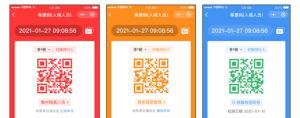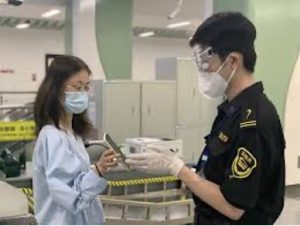Humans dictated by computer system in China.
Anonymous | June 24, 2022
Since the COVID-19 outbreak in early 2020, Chinese governments introduced a color-coded digital health system to monitor and dictates their citizens’ movement based on their personal data.

The different UI interface of the health software.
This health software issues the Chinese citizens a colored health code (green, yellow, or red), and based on the color they can determine if they are allowed leave the house. “Anyone with a red or yellow code is not allowed to travel. A red code means you either have or likely have the coronavirus, while a yellow code means you have had contact with another infected person.” (Ankel, 2020) In order to generate the color, the software system have to collect very personal and sensitive information from each person. The software is available on both WeChat (Instant-messaging app) and Alipay (Mobile payment platform), and the coverage of those software in China is more than 95%. Thus, it is important to evaluate the privacy policy of this health software.
I will use Solove’s Taxonomy privacy framework to analyze the health software’s privacy policy. The framework describes potential breaches of privacy through the lens of a user at the points of information collection, processing, dissemination, and possible invasion. At the data collection stage, based on the privacy policy, there exists interrogation from Chinese government, there is barely any consent acquirement process. “Only 3 cities in 14 provinces and 300 cities have informed consent and privacy protection policies.” (PengPai, 2020) At the same time, I did find a lot of surveillance happening, the software tracks your cellphone locations to make sure that you have not being to places that you are not allowed. “Experts and activists have criticized China’s mass surveillance and are questioning what else this data is being used for”. (Ankel, 2020)

A passenger shows a green QR code on his phone proving his health status to security upon arrival at Wenzhou railway station.
At the data processing stage, I am concerned about the secondary use of data, because the retention policy is completely missing, as a user of the app, I can see all my records since the Covid started, so the data is being kept forever. “So, there’s a concern that although this data is being perhaps collected for a legitimate purpose, that it could potentially and eventually be misused in ways that we can’t predict right now.” (Ankel, 2020) Identification is also an issue, the data collected contains details like body temperature, health background, and contact information. With all of that information, Chinese government could easily track down anyone.
In the information dissemination stage, there is no sign of Chinese government breaching the confidentiality, since the data being collected are all Chinese citizens, and protecting citizens are always a priority for any country. The privacy policy also has issues regarding the increased accessibility, since the health system is deployed on WeChat and Alipay, it means that those two technology companies also have access to the data, which means a lot of engineers that don’t work for the government will have access to it, which increases the accessibility of the original personal data. The good news is that I did not see any appropriation or distortion. However, when I focused on the invasion, based on the color code researchers have “seen the use of big data to predictive policing and detain people really for no reason.” (Ankel, 2020)
Conclusions
All in all, the privacy policy of the health software for Covid monitoring have a lot of areas that needs improvement. Asking for consent from the citizens should be the first thing to add. Although Chinese government is protecting the data and using it for the citizens’ good, the government should still provide a more detailed guidelines of the data collection, and data usages.
References
Ankel, S. (2020, April 7). As China lifts its coronavirus lockdowns, authorities are using a color-coded health system to dictate where citizens can go. here’s how it works. Business Insider. Retrieved July 1, 2022, from https://www.businessinsider.com/coronavirus-china-health-software-color-coded-how-it-works-2020-4#to-start-traveling-again-people-have-to-fill-out-a-questionnaire-that-asks-for-details-like-body-temperature-and-health-background-the-software-then-analyzes-it-and-generates-a-color-code-green-yellow-or-red-that-identifies-a-persons-health-status-5
Only 3 places in 14 provinces and cities have informed consent and privacy protection clauses. 澎湃新闻. (2020). Retrieved July 1, 2022, from https://www.thepaper.cn/newsDetail_forward_7210904
